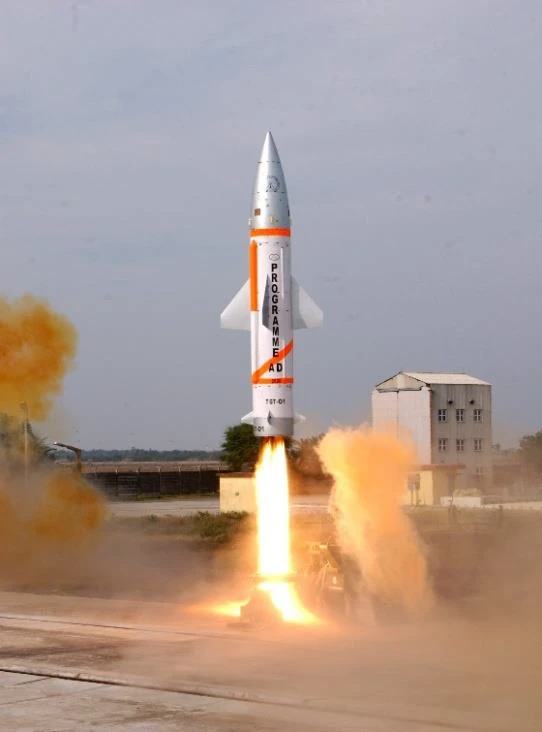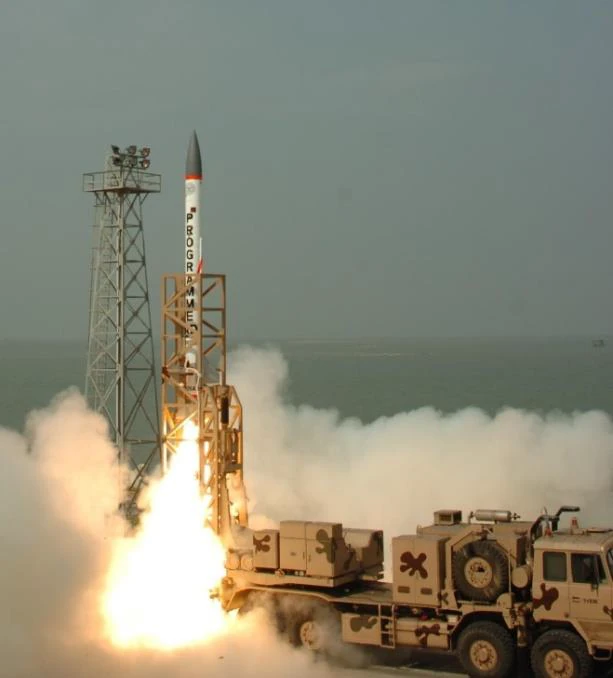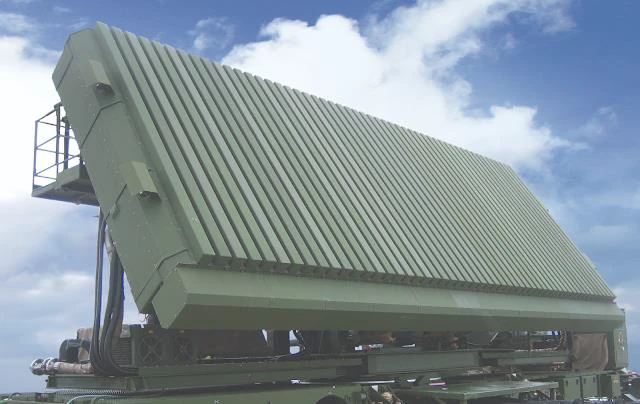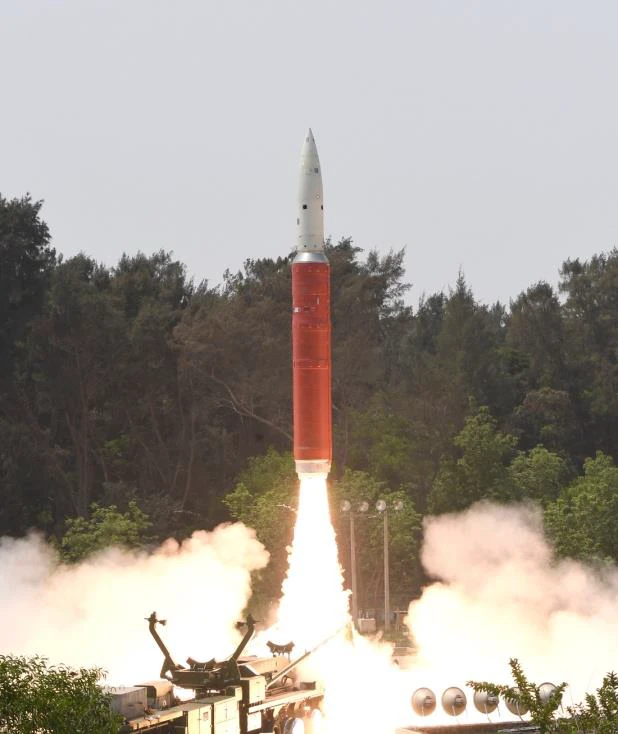India’s nuclear policy of “No First Use” necessitates that the country is prepared to absorb the first strike while retaining the ability to retaliate. Retaining such second-strike capability will necessitate India’s deployment of an effective missile-defence barrier to deflect some or all hostile inbound vectors before they can cause any harm to the country’s infrastructure or war-fighting equipment.
On November 2 2022, India’s Defense Research and Development Organization (DRDO) successfully tested the AD-1 Interceptor Missile, contributing to the first half of Phase 2 of India’s BMD System. Intermediate Range Ballistic Missiles (IRBM) such as Pakistan’s Ghauri and Shaheen Missiles and China’s Dongfeng 21 (DF-21) could be intercepted and destroyed by the AD-1. The AD-2 Interceptor Missile, which can intercept cruise missiles, is still undergoing development.
First Phase of BMD
The Indian Ballistic Missile Defense (BMD) Program (BMDP) was initiated after the 1999 Kargil War and aimed to construct a multilayered BMD System to safeguard India from ballistic missile threats. Under the BMDP, India intends to deploy a BMD system with low- and high-altitude interceptor missiles. In Phase 1, the outer layer for high-altitude interception currently consists of the Prithvi Air Defence (PAD) Hypersonic Missile Interceptor, which can intercept and destroy missiles at altitudes between 50 and 180 kilometres. The PAD comprises a first stage powered by solid fuel and a second stage powered by liquid fuel. The interceptor is equipped with an active phased array radar that can track 200 targets at 600 kilometres. In its initial live-fire test in November 2006, the PAD successfully intercepted a Prithvi-II ballistic missile at the height of 50 kilometres. This Prithvi-II Missile was modified to replicate the trajectory of China’s M-11 nuclear-capable ballistic missile (export version of DF-11 Short-Range Ballistic Missile). This made India the fourth nation in the world to successfully build and test a BMD system. On March 6, 2009, a second PAD test was conducted against a Dhanush Missile (a ship-launched variant of Prithvi), with missile tracking performed by India-made Swordfish Radar and successful interception and destruction achieved at the height of 75 kilometres.

The second or inner layer for low-altitude interception is the Advanced Air Defence (AAD) Supersonic Missile Interceptor (SMI), which is outfitted with a single-stage solid-fuel motor and a 200-kilometre operational range to intercept and neutralise hostile missiles in the endo-atmosphere at altitudes between 15 and 40 kilometres and speeds below Mach 5. The AAD SMI is equipped with an Inertial Navigation System (INS) and relies on ground-based tracking radars for trajectory updates. For interception, the interceptor employs active radar homing during the terminal phase. The AAD was successfully tested in December 2007 and again on March 6, 2011, at the Integrated Test Range in Chandipur, Odisha, intercepting and destroying a modified Prithvi target missile. AAD Interceptors with improved accuracy and manoeuvrability were tested twice in 2015, as well as in May 2016, December 2017, and August 2018 – with the most recent test demonstrating the successful interception and destruction of one of the multiple incoming targets simulating an incoming hostile IRBM. Currently, Phase 1 of the BMD’s development is considered complete.

Short-Range Interception in the BMD (as opposed to Point Air Defence [AD] supplied by AD guns, shoulder-fired missiles, and other short-range AD weapon systems) will be accomplished using missile systems like the Akash Surface-to-Air Missile (SAM). Akash is a road-mobile SAM system placed atop a self-propelled (wheeled/tracked) Akash Launcher and is deployable in single/multiple battery configurations with a 95% kill probability. Akash is included in the inventory of both the Indian Air Force (IAF) and the Indian Army (IA). The Akash New-Generation (NG) SAM is equipped with a solid-fuel rocket motor, providing higher dependability and a range of up to 70 kilometres. Active Electronically Scanned Array (AESA) Multi-Function Radar is mounted on the NG version.
Additionally, it is equipped with an upgraded proximity fuse capable of optical target detection. The Akash Prime model is intended for the IA and has a range of up to 50 kilometres. To increase kill probability, it is equipped with an active radio-frequency target seeker with a target lock-on range of roughly 15 kilometres. This model has been optimised for the high-altitude, low-temperature circumstances frequent throughout India’s borders, particularly at the Line of Actual Control opposite China and the Line of Control against Pakistan.
The IA has subsequently made operational two Akash Regiments and has requested two additional Akash Prime regiments for 2019. The IAF sought to acquire 1,000 SAMs or 125 for each squadron. The delivery of eight squadrons to the IAF, which have been dispersed across the country, is complete. Included in the BMD shield is the Russian S-400 Triumf AD System.
The BMD Phase 2
The AD-1 is a long-range interceptor missile designed for both low exo-atmospheric and endo-atmospheric interception of long-range ballistic missiles with ranges up to 3000 km, as well as aircraft, particularly high-value Airborne Early Warning & Control Aircraft. This is the case because the AD-1’s manoeuvrability would rely mostly on aerodynamic control surfaces and not rocket engines, which are needed for exo-atmospheric manoeuvrability. It is propelled by a two-stage solid-fuel motor and is equipped with an indigenously-developed advanced control system, navigation system, and guidance algorithm to precisely guide the vehicle to the target—an essential requirement for achieving an intersection flight path with an incoming high-velocity ballistic missile! True intercontinental ballistic missiles with ranges upto/over 5000 km and apogees well clear of the earth’s atmosphere would require an exo-atmospheric interceptor with thrust vector control/onboard rocket thrusters to manoeuvre in a near-vacuum environment; this requirement is likely to be met by the under-development AD-2 Interceptor, as part of Phase 2 of BMD.

Phase 2 of BMD will also necessitate larger detection ranges and, thus, over-the-horizon (OTH) target acquisition/tracking radars. The interceptors must be hypersonic (speeds greater than Mach 5) with exceptional manoeuvrability and the ability to resist any foreseen/deployable interceptor countermeasures onboard such ballistic missiles. DRDO is constructing an OTH tracking radar for BMD Phase 2 based on the Swordfish Long-Range Tracking Radar (LRTR), a derivative of the Israeli EL/M-2080 Green Pine long-range radar. The LRTR would be responsible for target acquisition and firing control for the BMD’s vectors. It can provide exo-atmospheric guidance to BMD missiles at altitudes greater than 80 kilometres and can simultaneously detect and track 200 hypersonic targets. DRDO is extending the range of the LRTR to 1,500 kilometres. The radar will incorporate over 80% indigenous components, including transmit/receive modules, signal processors, computing systems, and power packs, in keeping with India’s Make in India policy for decades.
System Engineering
To shorten response time, the BMD Phase 2 system architecture would consist of launch vehicles controlled by Launch Control Centres (LCC) dispersed across a large geographical area. In turn, the LCCs and Early Warning Radars would be connected to a Mission Control Centre (MCC). The entire system would be networked by redundant and secure communication lines across several media to establish a Wide Area Network. The MCC would perform target identification/classification, target-interceptor matching, and target assignment based on inputs from EW radars. Additionally, the MCC would conduct a post-interception evaluation to certify the neutralisation of the incoming hostile vector.
Prithvi Defence Vehicle (PDV)
Phase 1 of BMD (PAD/AAD) will be superseded by PDV, which DRDO is currently developing. The PDV would be a two-stage Interceptor powered by solid fuel. April 2014, February 2017 and February 2019 saw the conduct of three successful tests. On March 27, 2019, India conducted Mission Shakti to test an anti-satellite weapon by intercepting a Low-Earth-Orbit satellite with the PDV’s kinetic interceptor. PDV Mark 2 was a 13-meter-tall, three-stage interceptor that weighed close to 19 tonnes, with solid-fuel engines comprising the first two stages and the kinetic kill vehicle comprising the third stage. The PDV Mark 2 employs an Imaging Infra-Red Seeker to home in on a target and is capable of exo-atmospheric interception. Further enhanced models will likely intercept Intercontinental Ballistic Missiles (ICBM), thereby completing the BMD. Presently, the PDV Mark 2 is ready for Limited Series Production.

A long way to go
The aforementioned missile components of the BMD System in their current form would be ineffective against cruise missiles. However, the Akash/Medium Range Surface-to-Air Missile (MRSAM) and its variants would be able to defend against such vectors. As a result, they would also be included in the country’s overall AD/missile shield. The Anti-Access Area Denial scheme that China has in place could be successfully neutralised by an efficient Ballistic Missile Defense shield that is placed over India. It is possible to guarantee temporally and spatially extensive area security by increasing the inclusion of multilayer BMD and improving the kill probability of its vectors.
